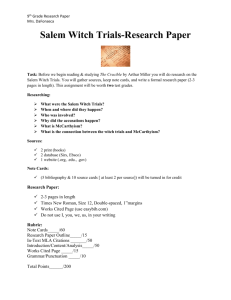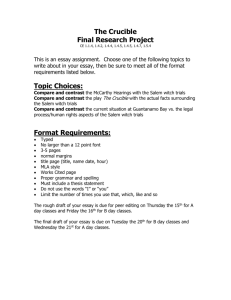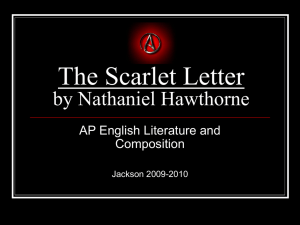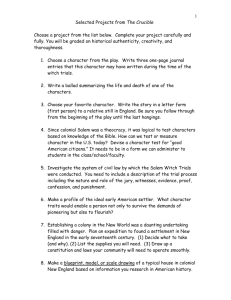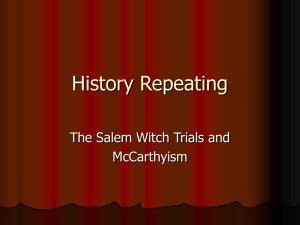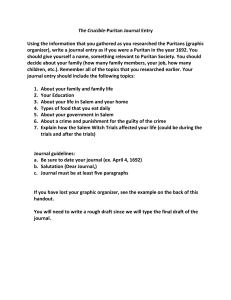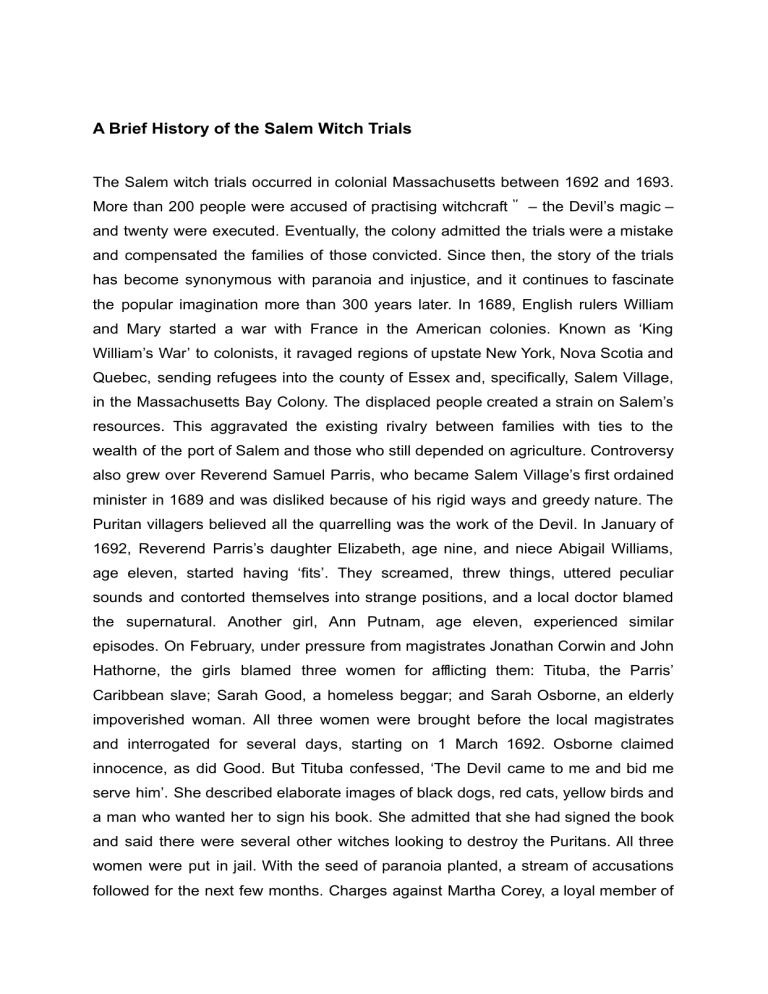
A Brief History of the Salem Witch Trials The Salem witch trials occurred in colonial Massachusetts between 1692 and 1693. More than 200 people were accused of practising witchcraft" – the Devil’s magic – and twenty were executed. Eventually, the colony admitted the trials were a mistake and compensated the families of those convicted. Since then, the story of the trials has become synonymous with paranoia and injustice, and it continues to fascinate the popular imagination more than 300 years later. In 1689, English rulers William and Mary started a war with France in the American colonies. Known as ‘King William’s War’ to colonists, it ravaged regions of upstate New York, Nova Scotia and Quebec, sending refugees into the county of Essex and, specifically, Salem Village, in the Massachusetts Bay Colony. The displaced people created a strain on Salem’s resources. This aggravated the existing rivalry between families with ties to the wealth of the port of Salem and those who still depended on agriculture. Controversy also grew over Reverend Samuel Parris, who became Salem Village’s first ordained minister in 1689 and was disliked because of his rigid ways and greedy nature. The Puritan villagers believed all the quarrelling was the work of the Devil. In January of 1692, Reverend Parris’s daughter Elizabeth, age nine, and niece Abigail Williams, age eleven, started having ‘fits’. They screamed, threw things, uttered peculiar sounds and contorted themselves into strange positions, and a local doctor blamed the supernatural. Another girl, Ann Putnam, age eleven, experienced similar episodes. On February, under pressure from magistrates Jonathan Corwin and John Hathorne, the girls blamed three women for afflicting them: Tituba, the Parris’ Caribbean slave; Sarah Good, a homeless beggar; and Sarah Osborne, an elderly impoverished woman. All three women were brought before the local magistrates and interrogated for several days, starting on 1 March 1692. Osborne claimed innocence, as did Good. But Tituba confessed, ‘The Devil came to me and bid me serve him’. She described elaborate images of black dogs, red cats, yellow birds and a man who wanted her to sign his book. She admitted that she had signed the book and said there were several other witches looking to destroy the Puritans. All three women were put in jail. With the seed of paranoia planted, a stream of accusations followed for the next few months. Charges against Martha Corey, a loyal member of the Church in Salem Village, greatly concerned the community; if she could be a witch, then anyone could. Magistrates even questioned Sarah Good’s four-year-old daughter, Dorothy, and her timid answers were construed as a confession. The questioning got more serious in April, when Deputy Governor Thomas Danforth and his assistants attended the hearings. Dozens of people from Salem and other Massachusetts villages were brought in for questioning. On 27 May 1692, Governor William Phipps ordered the establishment of a Special Court. The first case brought to the court was Bridget Bishop, an older woman known for her gossipy habits and promiscuity. When asked if she committed witchcraft", Bishop responded, ‘I am as innocent as the child unborn’. The defence must not have been convincing, because she was found guilty and, on 10 June, became the first person hanged on what was later called Gallows Hill. TRUE / FALSE / JUSTIFICATION. Read the text about the Salem Witch Trials. Decide whether the statements (1–6) are true (T) or false (F), then write the first four words of the sentence which supports your decision. Q1 People are still interested in the story of the Salem Witch Trials because they symbolise paranoia and injustice. (T) [Since then, the story…] Q2 In Salem Village, there was a rivalry between the farmers and those making money from the port. (T) j[This aggravated the existing…] Q3 Reverend Samuel Parris was a popular local minister. (F) [Controversy also grew over…] Q4 One of the accused women said the devil had told her what to do. (T) [But Tituba confessed, ‘The…] Q5 Only elderly or isolated women were questioned or brought to court. (F) [Charges against Martha Corey…] Q6 The first woman to be hanged as a witch proclaimed her innocence in court. (T) [When asked if she…] TEEN FORUM The term ‘witch hunt’ is used today when people are persecuted based on exaggerated or false claims. What do you consider modern-day ‘witch hunts’? Write your comment (80-100 words) I consider modern-day ‘witch hunts’ as a possible phenomenon, because of some news than can be fake, but, althought that, are diffused by social medias and other information canals, so people that read them are convinced of what they are reading, and so they share them, creating a catena. The wrong conviction of something that is for example connected with other people, can bring to a hunt of that people, not necesarily in a physical way, but in a discrimnitation way.

